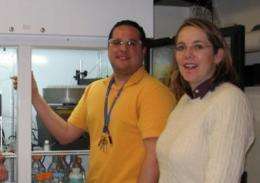X-ray crystallography study finds way to allosterically inhibit disease-related enzyme caspase-6

Perhaps no other biochemist in the world has his own baseball card, but University of Massachusetts Amherst doctoral student Elih M. Velázquez-Delgado, who gave up a pitching career for science, does. Now the only stats he cares about are experimental data, because, he says, "I fell in love with the fact that I can see a molecule. I can actually see an enzyme and watch how it functions. That captured me."
A native of Puerto Rico who pitched for five seasons in the minors, the Arizona and California Leagues, for the Oakland A's and San Francisco Giants' organizations, Velázquez-Delgado says his fast ball was hot enough but he lacked the "killer instinct" required to make it in the majors. He reflects, "I may have the ability but not the mindset."
While pursuing an undergraduate degree in chemistry from the Universidad del Turabo in Puerto Rico, Velázquez-Delgado came to UMass Amherst in 2006 as an under-represented minority student summer intern with the help of the Northeast Alliance for Graduate Education and the Professoriate. He says, "I fell in love with what we do here. So I came back after I graduated to pursue a PhD degree."
Now he is working on his doctorate in the chemistry laboratory of Professor Jeanne Hardy and is about to publish his first academic paper with her. They report discoveries about an enzyme that's causally involved in Alzheimer's and Huntington's diseases in the current issue of the journal, Structure.
Though now a biochemistry researcher, Velázquez-Delgado still measures success in baseball terms. "The difference between being a good hitter and a bad one comes down to only 3 hits in 10 at-bats," he explains. "If you bat .300 or miss about 7 of 10 opportunities, you'll get somewhere. But if you bat .200 or miss 8 of 10 at bats, you're not going far."
"In research I feel it's the same. If you can get the same 30 percent success rate you'll be awesome. So not being depressed about the seven misses is a skill. If you work hours and hours, devoting your life to it, you'll shave that edge down until you succeed."
Hardy, his advisor, says Velázquez-Delgado has solved "a very difficult problem" in a remarkably short time. The goal was to use her lab's expertise in X-ray crystallography to find a way to allosterically inhibit, that is block the action of, the disease-related enzyme caspase-6. In practical terms, she points out, "if you can understand how nature inactivates caspase-6, you can perhaps make a drug that uses the same mechanism and find a treatment for the disease."
Caspase-6 is one of a family of enzymes that "chew up" or cut other proteins and are sometimes depicted as miniature Pac-man characters, all mouth, the chemists explain. One technique that has been used to inhibit their disease-causing cuts in biologically important proteins is to target the "mouth" location, figuratively shoving something in to stop it from chewing.
But the biochemists also know that nature uses another technique, exploiting a different site on the enzyme and inhibiting it there through a natural process called phosphorylation. Velázquez-Delgado proposed to use X-ray crystallography to see, with molecular precision, how nature inactivates caspase-6 and perhaps imitate that approach.
"Phosphorylation adds two electrical charges, so most people have assumed that they're critical to the inhibitory action," Hardy explains. "But in fact, in this whole class of enzymes nobody had ever studied how this kind of inhibition works. We suspected it was allosteric, that is not based on the "mouth" or active site, but on the position of an "ear" on the protein, but we had no idea of the molecular mechanism."
Caspases' active sites are composed of four mobile loops that can take a variety of positions. When the protein is phosphorylated at a position outside the active site, one of the four active site loops is forced in the wrong conformation for substrate binding, which means it can't cut substrate and lead to the disease state. Through a series of experiments that Hardy calls "clean and beautiful," Velázquez-Delgado discovered how to induce this non-binding state and reverse it again. His structural detective work suggested that by cutting off just one amino acid, the caspase would again be inhibited even in the phosphorylated state. He did the experiment, and it turned out to be correct.
"He found that of more than 5,000 atoms in the protein, if we delete three of those atoms, we reverse the effect and inhibition by phosphorylation doesn't happen. Those three atoms control this function. It's a completely new way to inhibit caspase-6, and it opens the door to developing a drug that works by the same mechanism," Hardy says.
Provided by University of Massachusetts at Amherst

















